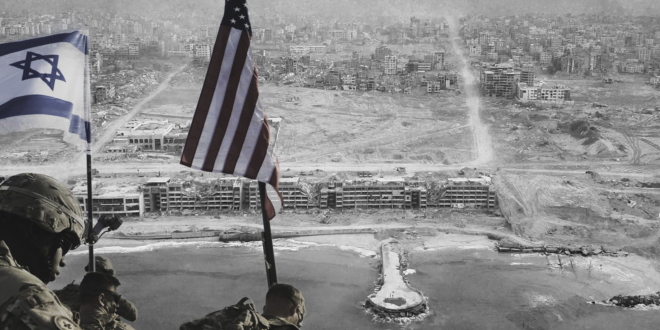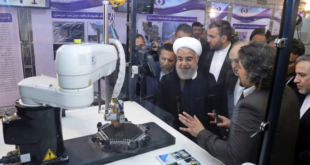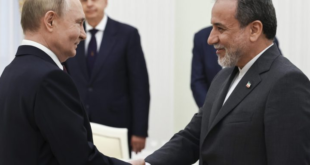While presented to the world as a humanitarian effort, the US-led ‘Maritime Corridor’ in Gaza is a strategic maneuver aimed at consolidating US and Israeli control over land and sea.
Israel’s brutal military assault on Gaza, which has killed over 35,000 civilians, predominantly women and children, has been executed alongside the denial of humanitarian aid since the war’s onset last October.
With cases of famine already in evidence, Tel Aviv’s utter disregard of the recent International Court of Justice (ICJ) ruling demanding immediate access to aid, and Washington’s veto of UN Security Council resolutions advocating for a Gaza ceasefire, both Israel and the US have come under significant global fire.
This backlash is notably strong on the campuses of major US universities, a growing student movement that has arguably breathed new life into the Palestinian solidarity movement. Concerns about the Gaza genocide’s potential damage to the global image of the US have belatedly reached the White House, with US President Joe Biden only now threatening – in advance of the November elections – to curtail the transfer of large offensive munitions to Israel.
A Maritime Corridor for Gaza
Curiously, despite his robust support of Israel’s Gaza assault until recent days, Biden appeared to take an atypical stance during his 7 March State of the Union address:
Tonight, I’m directing the US military to lead an emergency mission to establish a temporary pier on the Gaza coast in the Mediterranean. This pier will facilitate the arrival of large ships loaded with food, water, medicine, and temporary shelters.
That atypical initiative, during a period when hundreds of tons of US weapons were being airlifted to Israel daily, raises many questions about whether the establishment of a temporary pier in Gaza – under the guise of ‘humanitarian’ concern – is purely aimed at mitigating international criticism, or if it also serves Washington’s broader geopolitical objectives in the region.
If the US was indeed concerned about rushing aid to Gaza on an urgent basis, it could simply have done so via the Strip’s many land border crossings with Israel and the Egyptian one with Rafah, where hundreds of aid trucks have been lined up for months to deliver emergency food and medicine.
So why delay land aid for months to build a sea pier, one that potentially violates international maritime law? And is “humanitarian aid” just a ruse to occupy the seacoast of Gaza illegally?
According to Washington’s narrative, the maritime corridor is intended to facilitate the delivery of humanitarian aid from Cyprus to Gaza via a new pier. The corridor plans to start with 90 trucks rolling off to Gaza, and then scale up to 150 trucks. However, this volume is still far below the hundreds of trucks needed daily.
There are several hurdles and concerns associated with the maritime corridor. The operations will include Israeli inspections in Cyprus, which could lead to delays and complications. The sensitivity around inspections and security, especially concerning items deemed as “dual-use” goods (usable for both civilian and military purposes) – which in the past, per Israeli diktats, have included biscuits, chickens, and toys, and today includes maternity kits, sleeping bags, and dates – could impede the smooth processing of aid.
In its provisional measures decision, the ICJ emphasized that humanitarian aid to Gaza must not be obstructed. Therefore, Israel’s blockade has become void under normal circumstances.
In maritime operations, if a blockade is applied, no ships should be able to enter the area. Now, since the US has established a humanitarian corridor, this effectively nullifies the blockade and helps Tel Aviv pretend there isn’t one. Consequently, the US is practically invalidating the blockade decision recorded in the provisional measures decision by the ICJ, which was not supposed to be implemented – a legal loophole to provide succor to Israel’s massive international law violations.
Humanitarian aid or geopolitical strategy?
There’s significant political tension surrounding the corridor, with plenty of suspicions that it might slow down land routes or be associated with a siege strategy. The involvement of military entities and international politics adds layers of complexity and potential for delays or the politicization of aid.
Another aspect that casts doubt on the efficacy of the humanitarian aid corridor is its reliance on the Netzarim Corridor, also known as Route 749, imposed by the occupation army during the carnage. This east–west passage divides the northern and southern regions of the Gaza Strip and is a fortified road constructed by the Israeli army primarily for military access.
The route’s strategic placement and military significance complicate the entry and distribution of aid throughout Gaza. For the aid arriving through the maritime corridor, once the goods are offloaded at the pier, they still need to be transported across Gaza to reach the populations in need.
The Netzarim Corridor’s checkpoints could become bottlenecks for these deliveries. It is uncertain whether these checkpoints will allow seamless transportation of goods from the maritime corridor to the northern parts of Gaza, where famine has struck badly.
Consolidating control
Critics argue that the corridor could serve as a smokescreen for political maneuvers, posing a major threat not only to Gaza but to Egypt too, which stands to “lose its strategic advantage” over the Palestine file.
The suspicion is that the project, while ostensibly “facilitating” aid delivery, might also allow for increased control over the entirety of Gaza under the guise of humanitarian assistance. This control could potentially streamline Israel’s military operations and fortify its strategic positions within Gaza, ultimately influencing the broader geopolitical dynamics of the conflict.
Furthermore, the positioning of the pier may strategically protect Gaza’s nearby offshore gas fields, aligning with Israeli and US interests in stealing Palestinians’ energy resources.
The positioning of the aid entry points away from the northern parts of Gaza, where famine is most acute, to areas controlled by the Israeli army suggests a strategic alignment with Israel’s military objectives to remain physically in Gaza despite ceasefire negotiations that demand their complete exit from the Strip.
Concerns have also been raised about the potential for the US to take over control of the Egyptian border, effectively aiding in a permanent blockade of Gaza from Egypt, which could sever Gazans from access to any non-Israeli access to goods – forever.
In essence, while the maritime corridor could indeed alleviate a tiny portion of Gaza’s immediate humanitarian needs, its broader implications suggest a tangled web of geopolitical strategies.
Instead of establishing a floating pier for humanitarian aid, one of the most practical solutions is to send aid directly to Israel’s Ashdod Port, and from there to Gaza under UN supervision. However, in line with Israel’s military strategy, sending the aid through the Netzarim Corridor under Israeli military control to the assembly areas in the south of Gaza and directing the Palestinians to these aid points has facilitated the assault on Rafah.
Historical and strategic significance
To understand Washington’s geopolitical calculations, it’s worth examining Biden’s statements to Congress on 20 October 2023, in which he requested assistance for Israel’s security.
“This is a prudent investment. It will benefit American security for generations to come,” “We will make Israel stronger than ever,” and “We will build a good future in the Middle East.”
Palestine, situated at the crossroads between Asia and Africa and on the border of the Indian Ocean and the Mediterranean Sea, has been a source of contention since the earliest known great powers of history.
Historically, for powers in Africa or those controlling Egypt, Palestine has been key to securing the strategic Suez point for military strategy. Similarly, for powers in Asia or those emerging from the continent, controlling Palestine was crucial for accessing the Suez.
Today, the US faces the potential loss of access to the Bab el-Mandeb passage due to Yemen’s maritime operations in and around the Red Sea, which are now expanding to the Mediterranean. Such a loss would likely shift the balance of power in the Red Sea strategic area and further across West Asia.
When considering historical and current rivalries, it is evident that a significant benefit for Washington, as noted by Biden, is to control the Suez Canal through Tel Aviv.
It is plausible that Israel’s dominion over the Gaza Strip and the US control of the offshore waters of Gaza under the guise of humanitarian aid could facilitate US control over the exits of the Suez Canal, as well as the routes from Iran and Russia to the Eastern Mediterranean through Lebanon and Syria. The alignment of Israel’s objectives in Gaza with Washington’s strategic goals explains the continued US support of Israel – in spite of intensifying global outrage over its enabling of ethnic cleansing and land grabbing.
 Eurasia Press & News
Eurasia Press & News




